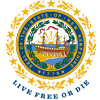Process
Information about the FirstNet New Hampshire Process.
The process of developing the Nationwide Public Safety Broadband Network (NPSBN) is organized into three phases: design, deployment and operation.
Design
The law that established FirstNet required consultations with Federal, State, tribal, and local public safety entities to ensure that the FirstNet network was designed to meet the needs of public safety across the country. State, tribal and local consultation was a collaborative process, involving key stakeholders and leadership from each state and territory, and will incorporate enhancements and improvements as they develop.
FirstNet worked with the designated single officer and governmental body during state and local planning consultation to gather requirements from key stakeholders for developing its deployment plan.
State and local planning consultation topics included:
- Construction of a core network and any RAN build-out
- Placement of towers
- Coverage areas of the network, whether at the regional, state, tribal, or local levels
- Adequacy of hardening, security, reliability, and resiliency requirements
- Assignment of priority to local users
- Assignment of priority and selection of entities seeking access to or use of the nationwide interoperable public safety broadband network and training needs of local users
FirstNet began its nationwide state and local planning outreach efforts in mid-May 2013 with six regional workshops. Ten individuals from each state and territory, including some tribal representatives, participated in these interactive meetings, where they communicated their requirements, priorities and concerns to FirstNet. This initial phase of consultation provided FirstNet with valuable insights. They learned how unique the coverage needs are in each state and territory and how different local and regional incident policies and procedures are at the local level.
Tribes and Federal Users
FirstNet created an education and outreach program to engage tribal leaders on the network and their public safety needs. In addition to encouraging the designated single officer or governmental body to include tribal nations in the FirstNet state consultation process, FirstNet held additional meetings with tribal representatives. Likewise, FirstNet engaged with a variety of federal agencies to determine how best to leverage their assets and expertise for the network.
State Visits
Building on the regional workshops, FirstNet maintained individual visits to each of the states and territories to continue the dialog about building a broadband network dedicated to public safety. FirstNet worked through each designated state point of contact to arrange a visit, agree on the agenda and identify participants. The agenda for initial FirstNet visits focused on roles and responsibilities, users and coverage needs. They also discussed expectations for data collection and other state-specific issues. These meetings paved the way for ongoing collaboration that resulted in FirstNet's development of 56 unique state deployment plans.
State Decision on FirstNet's RAN Plans
Members of the FirstNet outreach and design teams worked closely with the designated single officer and governmental body to develop and deliver a network deployment plan that met the needs of the state. FirstNet then provided the Governor of each state or territory with a notice of the completion of the request for proposal process; the details of the proposed plan; and the funding level for the state or territory. Upon receipt of the plan, a Governor had 90 days to choose whether to participate in the plan provided by FirstNet or conduct its own deployment of a radio access network (RAN). If a Governor decided to opt out, then he/she was required to notify FirstNet, NTIA, and the FCC. After providing the notification, the Governor had 180 days to develop and complete requests for proposals (RFPs) for the construction, maintenance and operation of the RAN within the State. The State would then be required to submit an alternative plan to the FCC that is interoperable with the NPSBN and comply with the minimum technical interoperability requirements under the Act.
All 50 states, five U.S. territories and Washington, D.C. have "opted in" to FirstNet, meaning each has accepted its individual State Plan detailing how the network will be deployed in their state/territory.
Deployment
FirstNet was created to be a force-multiplier for first responders – to give public safety 21st century communication tools to help save lives, solve crimes and keep our communities and emergency responders safe. To do that, FirstNet will build a new Band Class 14 network designed to be reliable, functional, safe and secure, and provide optimal levels of operational capability at all times. For the first time, public safety communications will be based on commercial standards. This will bring the benefits of lower costs, consumer-driven economies of scale and rapid evolution of advanced communication capabilities.
LTE Technology
The law states that the network shall be based on the minimum technical requirements on the commercial standards for Long Term Evolution (LTE) service. LTE is the evolution of a proven technology, which is now in its fourth generation (4G). With each generation comes improvement in speed and functionality. Standards set to enhance and evolve 4G LTE are continuing on a global basis. FirstNet is involved in the standards process and working closely with public safety organizations to support the development of standards and functionality that meet the needs of the public safety users that FirstNet will serve. Much of the current focus is on an international set of standards that will allow FirstNet to offer mission-critical voice (MCV) when these capabilities become available. The same MCV technologies will then work across all standards-based equipment and networks worldwide.
FirstNet broadly defines its LTE network in distinct layers: Core Network, Transport Backhaul, Radio Access Network (RAN) and Public Safety Devices.
Core Network
FirstNet is responsible for building the enhanced packet core network, a key component for ensuring that users have a single interoperable platform nationwide. The core network has six primary functions: it switches data, processes and reformats information, stores and maintains data and keeps it secure. Applications, services, operational, and business support systems also reside in the core network. The core will interface with other state, local and federal networks, including 911 and the internet.
Essentially, the core serves as a giant umbrella covering all of the US, including the territories and the District of Columbia. The core is connected to radio access networks in each state via the backhaul layer of the network.
Transport Backhaul
These are the links that carry user traffic, such as voice, data and video, and signaling from the radio base stations to the core network.
Radio Access Network (RAN)
The RAN portion of the network consists of the radio base station infrastructure that connects to user devices. RAN includes cell towers as well as mobile hotspots embedded in vehicles that backhaul to the core network over satellite or other types of wireless infrastructure.
Comprehensive RAN planning is required to optimize coverage, capacity and performance for a nationwide network. Initial modeling has shown that tens of thousands of radio base stations are needed to cover at least 99 percent of the population and the national highway system. Population coverage alone won't suffice for public safety. During consultation, FirstNet will work with the states to determine the coverage expectations and priorities that must be included in the RAN deployment plan to enable public safety to meet its mission, no matter where it takes them.
RAN Reliability
The very circumstances that can require first responders to come to the aid of others can also wreak havoc on RAN sites when first responders need coverage the most. Making a system reliable requires physical and operational redundancy and hardening.
Most network outages are due to power failures and the loss of data links. To be public safety-grade, FirstNet sites will need redundant power backup that relies on a variety of sources. Power, backhaul, sites and coverage will be designed with the goal of avoiding single points of failure.
Public Safety Devices
Devices are all the user access points that will send and receive information over the network. Everything from smartphones to laptops, tablets, dongles and a wide variety of specialty devices will be developed for FirstNet users. The goal is to create devices that are rugged enough to withstand the many public safety environmental issues, but still be easy to use and convenient to carry. Devices will also have to be easy to administer and secure.
With the potential for millions of users, FirstNet will have the scale and leverage to drive development and procurement of devices at the best possible prices. Scale will likely also spur interest from a number of new vendors, which can enhance vendor/design diversity, increase competition and help lower prices for public safety devices. In the future, FirstNet will work with the industry to develop device types and applications to meet public safety use cases identified by public safety users. FirstNet devices and applications will undergo a variety of testing and certification in areas including interference, operation, environmental factors and security.
Operation
FirstNet's goal is to have the network substantially in operation by 2022.
FirstNet's goal is to ensure there is service in all 50 US states, 5 territories, and the District of Columbia. The network will potentially connect over 4-13 million public safety users nationwide. Public safety users include federal, state, local and tribal and non-governmental law enforcement, fire, and emergency medical service entities, as well as non-traditional organizations that perform public safety services. The Law also allows for secondary users. These non-public safety users are subject to prioritization and/or preemption by public safety during incidents.




